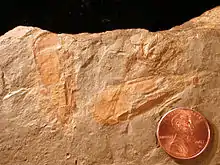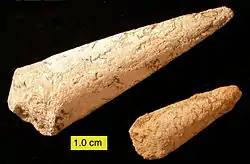软舌螺动物门
软舌螺动物(学名:)是生活在古生代的一类神秘動物,具有小圓錐形的螺殼。這些物種目前都已全部滅絕;其化石一般只能保存锥壳、口盖和附肢三个部分,外壳为钙质成分,两侧对称。根據形態學的分類,本物種是一类海生有壳的无脊椎动物,但再具體一點的分类众说纷纭:
| 软舌螺动物门 化石时期:早寒武世幸运阶 至 晚二叠纪[1][2][3] | |
|---|---|
 | |
| Hyolithes cerops, 爱达荷州,Spence Shale(中寒武世) | |
| 科学分类 | |
| 界: | 动物界 Animalia |
| 亚界: | 真后生动物亚界 Eumetazoa |
| 演化支: | 副同源异形基因动物 ParaHoxozoa |
| 演化支: | 浮浪幼虫样动物 Planulozoa |
| 演化支: | 两侧对称动物 Bilateria |
| 演化支: | 肾管动物 Nephrozoa |
| 演化支: | 原口动物 Protostomia |
| –未分级–: | 螺旋動物 Spiralia |
| 总门: | 冠輪動物總門 Lophotrochozoa |
| 演化支: | 触手冠动物 Lophophorata |
| 演化支: | 泛腕足動物 Brachiozoa |
| 门: | 软舌螺动物门 Hyolitha Marek, 1963 |
| 纲 | |
| |
近期以軟組織化石分析發現軟舌螺動物具有觸手冠 (Lophophore) 這種進食器官,指出軟舌螺動物其實應該獨立為一門,而且和包含腕足動物門在內的觸手冠動物 (Lophophorata) 較相近[4]。

形態學
软舌螺动物的碳酸鈣質外殼很大可能是由霰石組成[5]。 有口盖保護,還有兩條又名海倫體的彎彎附肢()去支撐身體,以邊緣增生的形式成長[5]。 體長一般在一公分到四公分,橫切面呈三角形或橢圓形。部份物種有環紋或條紋。
外殼
原状壳具有带横向束微结构的内层和包含纵向束的外层。[5]
附肢
本物種的附肢叫作「海倫體」,是一種長形的結構,在軟舌螺的腹側方向以對數形式逐漸盤繞[5]。
海倫體的外表為鈣質與有機物質的結合,內裡為有機物質豐富的中心部分,由片狀方解石質料形成的同心圓包圍。當軟舌螺成長時,海倫體的基部亦一同生長,使海倫體的體腔留下一條條的生長線[5]。由於這獨特的生長特性,海倫體最初被Walcott誤以為是獨立的化石個體,並被冠以「海倫螺屬」()這個屬名,因為Walcott的太太名為海倫娜,而他的女兒名為海倫。及後當Bruce Runnegar發現原來「海倫螺」其實是軟舌螺的部分時,他亦沿用「海倫」這名稱,成為現時「海倫體」這個稱呼[5]。
口蓋
口蓋緊緊的把殼關閉。 The operculum closes perfectly over the aperture of the shell, leaving two gaps through which the helens can protrude.[5]It comprises two parts: the cardinal shield, a flat region at the top of the shell; and the conical shield, the bottom part, which is more conical.[5]The inside of the shell bears a number of protrusions, notably the dorsal cardinal processes and the radially-arranged clavicles.[5]
分类

人们依据有无口唇将软舌螺动物门动物分成两个目:
- †有唇软舌螺目 Hyolithida
- †直管螺目 Orthothecida
Hyolitha have dorso-ventrally differentiated opercula, with the ventral surface of the shell extending forwards to form a shelf termed the ligula.[5]
The Orthothecida are somewhat more problematic, and probably contain a number of non-hyoliths simply because they are so difficult to identify with confidence, especially if their operculum is absent.[5]They have a straight (planar) opening, sometimes with a notch on the bottom side, and sealed with an operculum that has no ligula, clavicles, furrow or rooflets.[6]
Hyptiotheca is an unusual hyolithid, in that it lacks clavicles.[6]
Orthothecids fall into two groups: one, the orcothecida sensu stricto,[7]is kidney or heart shaped in cross-section due to a longitudinal groove on its ventral surface, and its opercula bear cardinal processes; the other has a rounded cross-section and often lacks cardinal processes, making them difficult to distinguish from other cornet-shaped calcareous organisms.[6]All were sessile and benthic; some may have been filter feeders.[7]
Phylogenetic position

Because hyoliths are extinct and do not obviously resemble any extant group, it is unclear which living group they are most closely related to. They may be molluscs; authors who suggest that they deserve their own phylum do not comment on the position of this phylum in the tree of life.[8]Their grade of organization is considered to be of the 'mollusc-annelid-sipunculid' level,[9]consistent with a Lophotrochozoan affinity, and comparison is usually drawn with the molluscs or sipunculids.[9][10]Older studies (predating the Lophotrochozoan concept) consider hyoliths to represent a stem lineage of the clade containing (Mollusca + Annelida + Arthropoda).[3]
生态
软舌螺可能是底栖生物。 寒武纪软舌螺是全球分布,没有迹象显示有地区差异,有迹象显示软舌螺有长寿命浮游幼虫生活期;但在奥陶系不同的组合变得越来越普遍。[6]
出现
最早的软舌螺壳体化石大约出现在5亿4000万年前的西伯利亚 Purella antiqua Zone 的Nemakit-Daldynian阶,其类似物发现于中国Paragloborilus subglobosus–Purella squamulosa Zone 的 梅树村阶(寒武纪第一个阶)。[11]。软舌螺动物门物種無論在其數量及其多樣性都在寒武紀達至巔峰,之後逐步遞減,直到滅絕。[2][12]
参考文献
- Kouchinsky, A.; Bengtson, S.; Runnegar, B.; Skovsted, C.; Steiner, M.; Vendrasco, M. . Geological Magazine. March 2012, 149 (2): 221–251 [2017-05-06]. doi:10.1017/S0016756811000720. (原始内容存档于2019-11-10).
- Malinky, J. M. . Journal of Paleontology. 2009, 83: 147–152. doi:10.1666/08-094R.1.
- Runnegar, Bruce; Pojeta, John; Morris, Noel J.; Taylor, John D.; Taylor, Michael E.; McClung, Graham. . Lethaia. 1975, 8 (2): 181. doi:10.1111/j.1502-3931.1975.tb01311.x.
- Moysiuk, Joseph. Martin R. Smith, Jean-Bernard Caron. . Nature. 2017. doi:10.1038/nature20804.
- Mus, M. Martí; Bergström, J. . Palaeontology. 2007, 50 (5): 1231–1243. doi:10.1111/j.1475-4983.2007.00700.x.
- Malinky, J.M.; Skovsted, C.B. . Acta Palaeontologica Polonica. 2004, 49 (4): 551–578.
- Malinky, J. M. . Journal of Paleontology. 2009, 83 (4): 588–596. doi:10.1666/08-164R.1.
- Malinky, John M. . Journal of Paleontology. 2009, 83: 147–152. JSTOR 29739075. doi:10.1666/08-094R.1.
- Runnegar, B. . Lethaia. January 1980, 13: 21. doi:10.1111/j.1502-3931.1980.tb01025.x.
- Kouchinsky, A. V. . Alcheringa: an Australasian Journal of Palaeontology. 2000, 24 (2): 65–81. doi:10.1080/03115510008619525.
- 钱逸 (编). . 北京 (中国): 科学出版社. 1999. ISBN 7-03-007599-4 (中文(简体)).
- Steiner, M.; Li, G.; Qian, Y.; Zhu, M.; Erdtmann, B. D. . Palaeogeography, Palaeoclimatology, Palaeoecology. 2007, 254: 67. doi:10.1016/j.palaeo.2007.03.046.